New Jersey may be one of the smallest states in the US, but it is still a phenomenal destination for birding.
Birders who live in or visit New Jersey can see all kinds of fascinating birds while they are here, including woodpeckers, hummingbirds, waterfowl, songbirds, corvids, birds of prey, and bluebirds.
New Jersey is made up of four regions: the Atlantic Coastal Plain, the Piedmont, the New England Upland, and the Valley Region. These four areas provide New Jersey’s birds with everything from farmland and mountains to cities and shorelines.
Among the many different birds in New Jersey are 18 different kinds of sparrows.
What Is a Sparrow?
According to The Spruce, “sparrow” is a catch-all term for “a wide range of relatively small, mostly drab brown birds, which birders often call ‘LBJs’ or ‘little brown jobs’ because they can be notoriously difficult to identify.”
Even though many sparrows have “sparrow” in their names, there are a few other kinds of birds that are in the sparrow family: buntings, towhees, and juncos are good examples.
All sparrows are Passerines, which makes them songbirds. Most are streaky brown birds that are between 4-8 inches long, and they have a short, sharp, conical bill. They are often quite vocal, but their songs and calls are not always very melodic. Sometimes they have an insect-like buzz or a loud chirping news.
They are good at camouflage, which means you may hear them before you see them. Or, if they are a quieter variety, you w may not even realize when they are nearby!
Are There a Lot of Sparrows in New Jersey?
Every year, there are 18 kinds of sparrows that regularly reside in or visit New Jersey. Some individual vagrants may accidentally end up in New Jersey from time to time, but the 18 on our list are the ones you have a real chance of seeing here.
Our list is to help you identify sparrows in New Jersey. That’s why we’re including the following traits:
- A physical description (size, weight, colors, and patterns)
- Where it can be found in New Jersey
- When it lives in New Jersey (or visits here)
- Interesting behaviors and habits
- Nesting and diet habits
This is important: it’s not always easy to figure out what kind of sparrow you are looking at. They look very similar to one another, and they often fly away before you can get a good look or a picture.
To make our list as easy to use as possible, we are dividing these 18 sparrows into four groups: those who are in New Jersey, those who stay for the breeding season, those who are here in the winter, and those who just happen to stop by during their migration windows in the spring and fall.
Ready to get started? Let’s learn about all 18 of these interesting sparrows.
Sparrows in New Jersey Year-Round
Field Sparrows, House Sparrows, Song Sparrows, and Swamp Sparrows are the only sparrows who stay in New Jersey year-round.
Although they may stay in one geographic area all year, they may still move between a summer habitat and a winter one. They will often choose the perfect area for nesting and then have more flexibility the rest of the year.
Field Sparrow
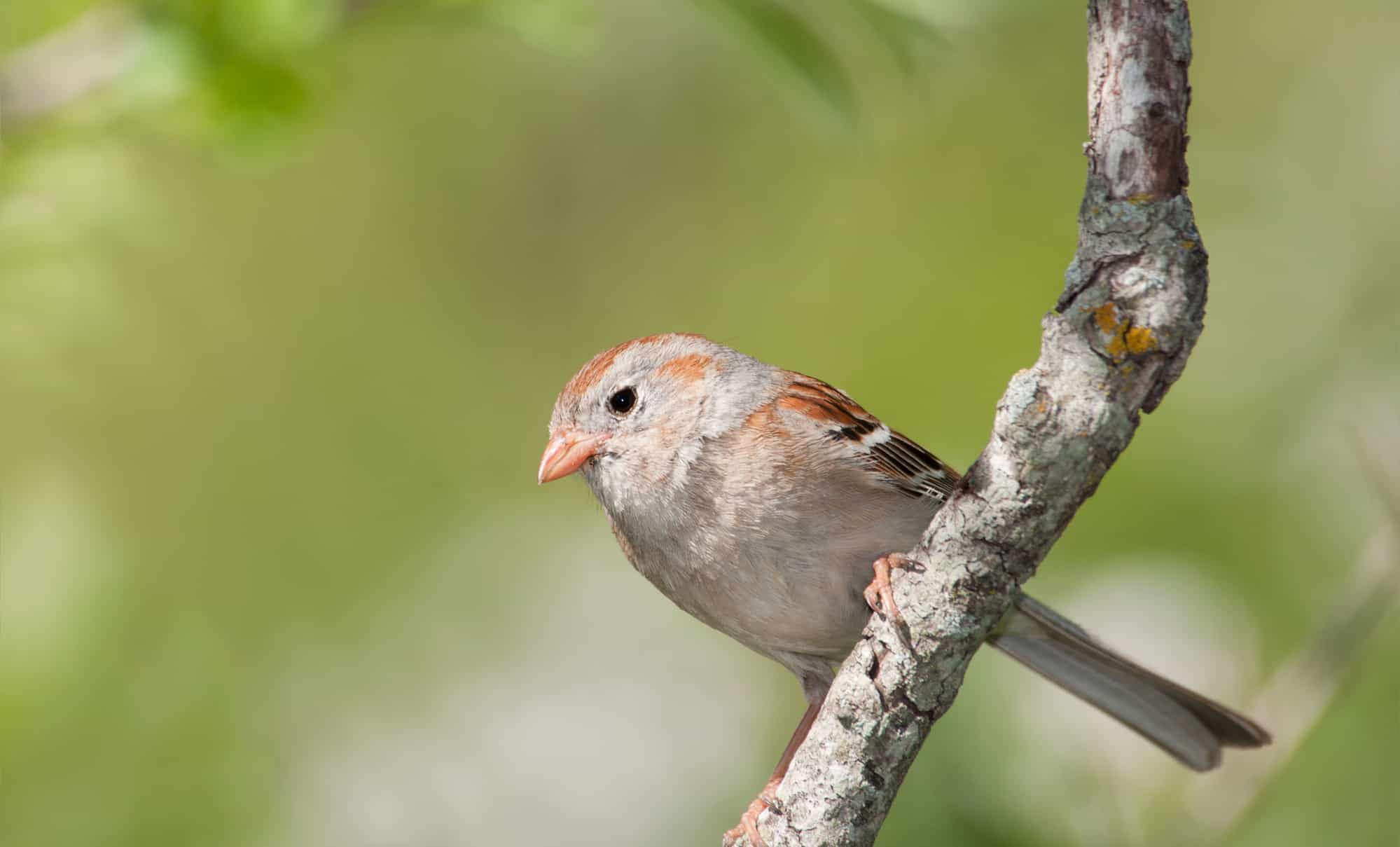
- Spizella pusilla
- ORDER: Passeriformes
- FAMILY: Passerellidae
- Length: 4.7-5.9 in (12-15 cm)
- Weight: 0.4-0.5 oz (11-15 g)
- Wingspan: 7.9 in (20 cm)
Male and female Field Sparrows are both gray with brown-streaked wings and backs. They have a white eyering and a pink bill, as well as a rust-brown cap.
They avoid humans and instead inhabit open fields and prairies. They are the victims of suburban expansion and habitat loss, so their numbers are declining.
They are year-round residents of New Jersey, but not in the state’s cities and large towns. They build their nests on the ground in tall grasses, although they may build a second nest higher in a bush or tree, especially if their first nest is destroyed by predators.
House Sparrow

- Passer domesticus
- ORDER: Passeriformes
- FAMILY: Passeridae
- Length: 5.9-6.7 in (15-17 cm)
- Weight: 0.9-1.1 oz (27-30 g)
- Wingspan: 7.5-9.8 in (19-25 cm)
House Sparrows earned their name from their habitat preferences: they live in the beams of rafters of human-made structures, including houses and barns.
They thrive in cities and are commonplace in New Jersey’s urban areas.
As a well-established invasive species, they cause problems for many native birds in North America. They will force other birds out of their nests, outcompete them for resources, and even kill them. They are likely the most aggressive North American sparrow.
Male House Sparrows have gray heads, white cheeks, a black bib, and a rufous neck. Females, on the other hand, are mostly brown, but they have stripes on their backs.
They are widespread throughout all of New Jersey. They are plentiful in urban areas, and in rural areas, they will live near solitary houses and businesses.
Song Sparrow

- Melospiza melodia
- ORDER: Passeriformes
- FAMILY: Passerellidae
- Length: 4.7-6.7 in (12-17 cm)
- Weight: 0.4-1.9 oz (12-53 g)
- Wingspan: 7.1-9.4 in (18-24 cm)
Song Sparrows have a lot of regional variation in their appearance. However, they all share some traits: brown coloring, white streaks on their chests, and thick white flanks. The amount of streaking varies from region to region, as does their overall hue, which can be light to reddish brown.
Song Sparrows use the same nesting ground every year, sometimes even returning to the exact same nest. If they abandon the nest, another Song Sparrow will likely move right in.
Song Sparrows have a diet of insects in the summer and seeds in the winter. Some migrate, but the population in New Jersey tends to stay put.
They are widespread throughout New Jersey and are found in thickets and brushy fields, as well as gardens and salt marshes.
Swamp Sparrow
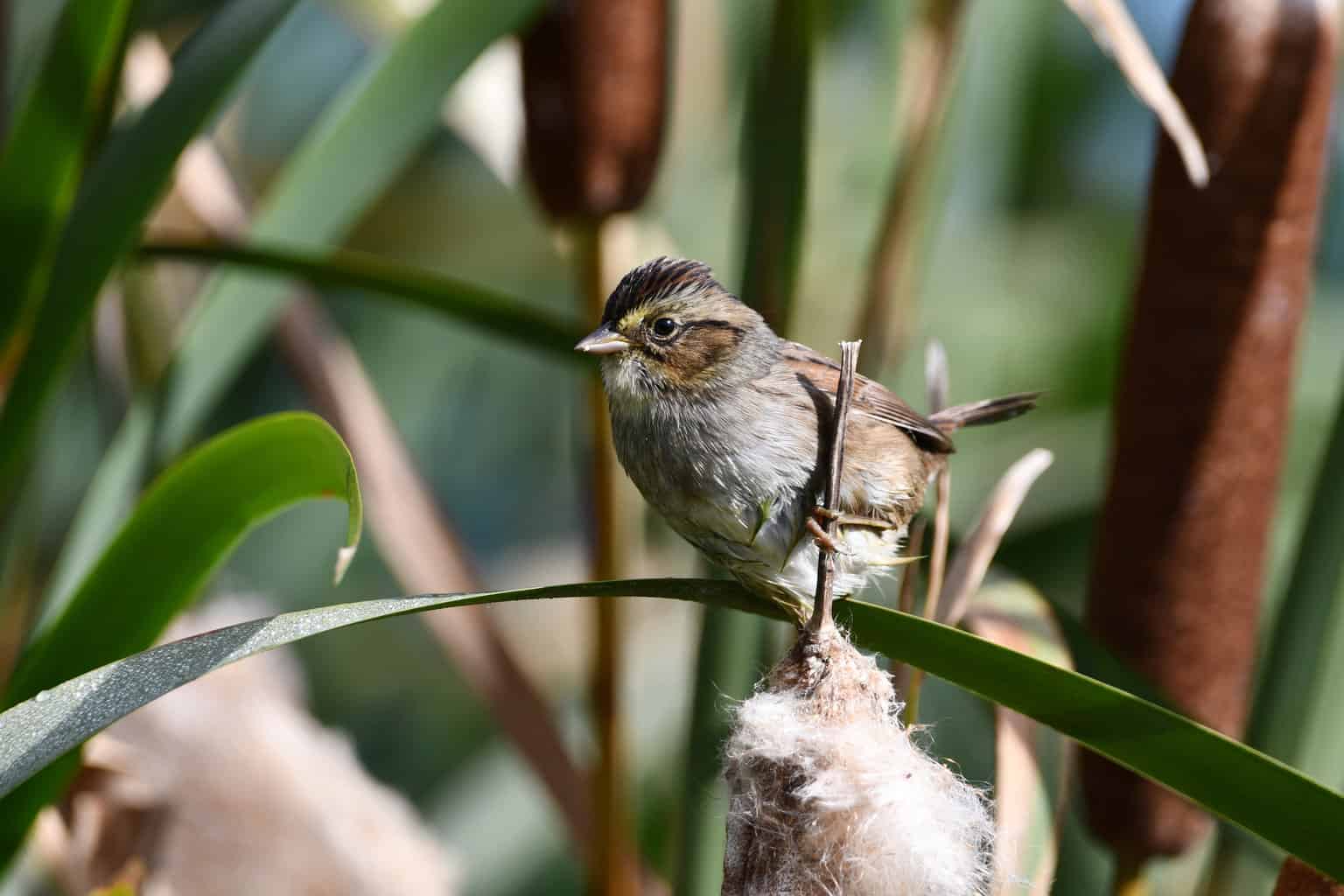
- Melospiza georgiana
- ORDER: Passeriformes
- FAMILY: Passerellidae
- Length: 4.7-5.9 in (12-15 cm)
- Weight: 0.5-0.8 oz (15-23 g)
- Wingspan: 7.1-7.5 in (18-19 cm)
Swamp Sparrows are sometimes confused for two other sparrows: the Song Sparrow and the Chipping Sparrow.
They have a very similar silhouette to the Song Sparrow, as both are round with long tails. They also have a reddish-brown cap, just like the Chipping Sparrow.
To avoid mix-ups, note that the Swamp Sparrow is much larger than the Chipping Sparrow, and far less social. Also, the Swamp Sparrow has more stripes than the Song Sparrow, and a reddish-brown cap.
The Swamp Sparrow also has big, strong legs for foraging through the mud in its preferred marshy habitats.
They are year-round residents of New Jersey. They nest exclusively in wetlands, including swamps and marshes. In the winter, they may live farther from the water, usually in thickets and underbrush. They hide from humans, but can sometimes be coaxed out of the thickets by friendly human vocalizations.
Summer-only Sparrows in New Jersey (Breeding Season Residents)
In addition to the year-round sparrows, there are 7 types of sparrows that come to New Jersey for the breeding season. These are the Chipping Sparrow, the Eastern Towhee, the Field Sparrow, the Grasshopper Sparrow, the Saltmarsh Sparrow, the Savannah Sparrow, and the Seaside Sparrow.
Chipping Sparrow
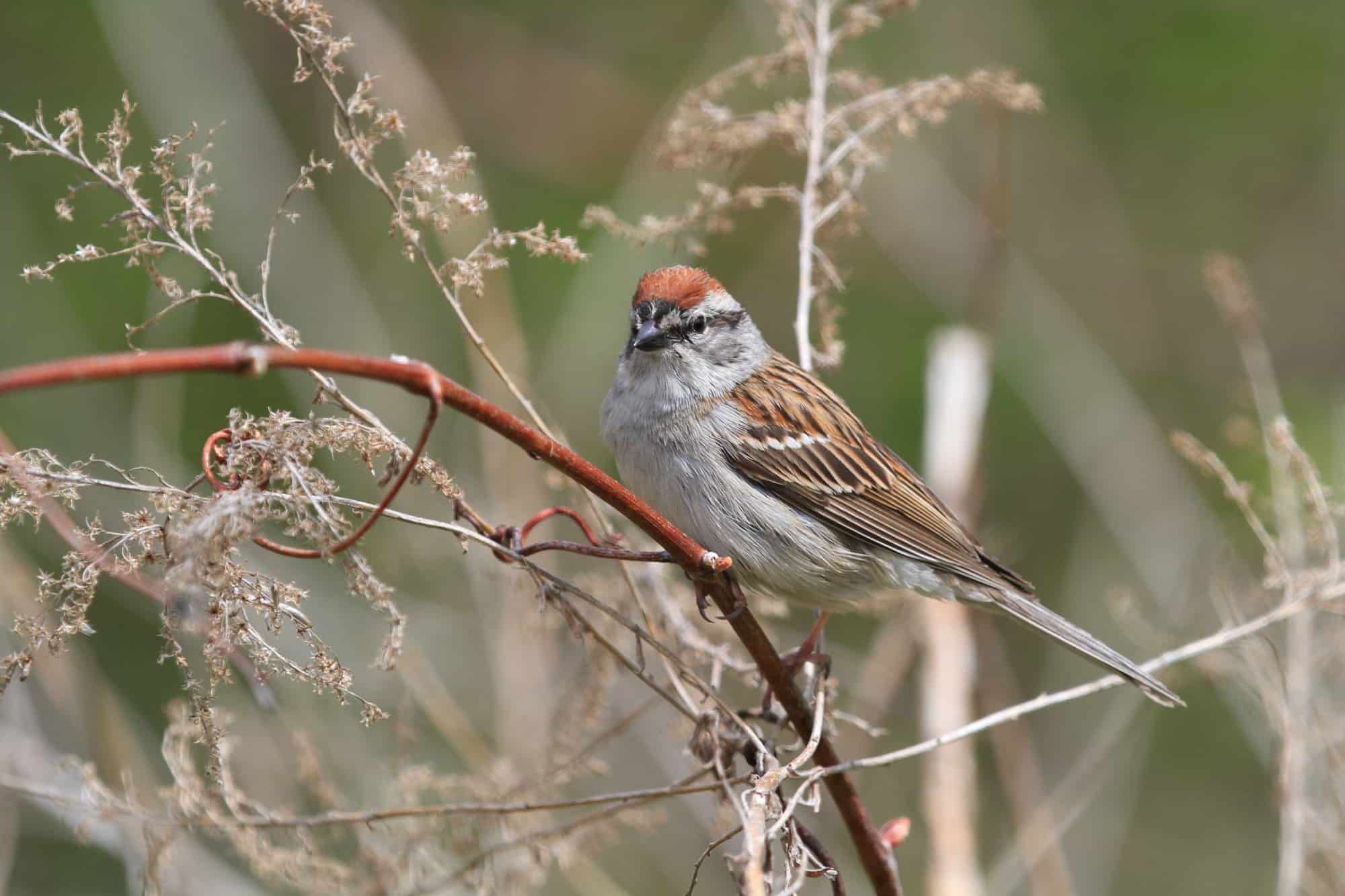
- Spizella passerina
- ORDER: Passeriformes
- FAMILY: Passerellidae
- Length: 4.7-5.9 in (12-15 cm)
- Weight: 0.4-0.6 oz (11-16 g)
- Wingspan: 8.3 in (21 cm)
Chipping Sparrows have a much larger breeding territory than winter territory. They nest and raise hatchlings in most of the US and almost all of Canada, but they only winter in Florida and Mexico. A few communities also live year-round in Southern California and the Caribbean.
Male Chipping Sparrows are crisply streaked in dark brown on the wings and back. His head is topped with a rufous cap. Females are similarly patterned but darker.
They are loud little birds whose trilling song can be heard from a distance. During the summer, when they nest in New Jersey, they contribute to pest control by consuming large amounts of insects and bugs. That includes grasshoppers, crickets, beetles, caterpillars, some spiders, and leafhoppers.
Their preferred habitat is in the forest and in New Jersey’s prairie grasslands. Their nest is built out of grass, weeds, and little pieces of tree roots. It is shaped like an open cup and is usually found in a conifer tree.
Eastern Towhee

- Pipilo erythrophthalmus
- ORDER: Passeriformes
- FAMILY: Passerellidae
- Length: 6.8-8.2 in (17.3-20.8 cm)
- Weight: 1.1-1.8 oz (32-52 g)
- Wingspan: 7.9-11.0 in (20-28 cm)
The tri-colored Eastern Towhee is one of the easiest sparrows to identify. Males have a dark black head, back, and neck, a white belly, and rufous sides.
Females have the same pattern, but they are brown in all the places where males are black.
They have a call that sounds like “chewink.” Their cup-shaped nests are usually built right on the ground, but sometimes they are also in honeysuckle, Greenbriar, or grape tangles, up to about 4 feet above the ground.
You will find them in New Jersey’s shrubby fields and wooded areas, especially if there is a lot of ground cover for them to hide in.
Grasshopper Sparrow
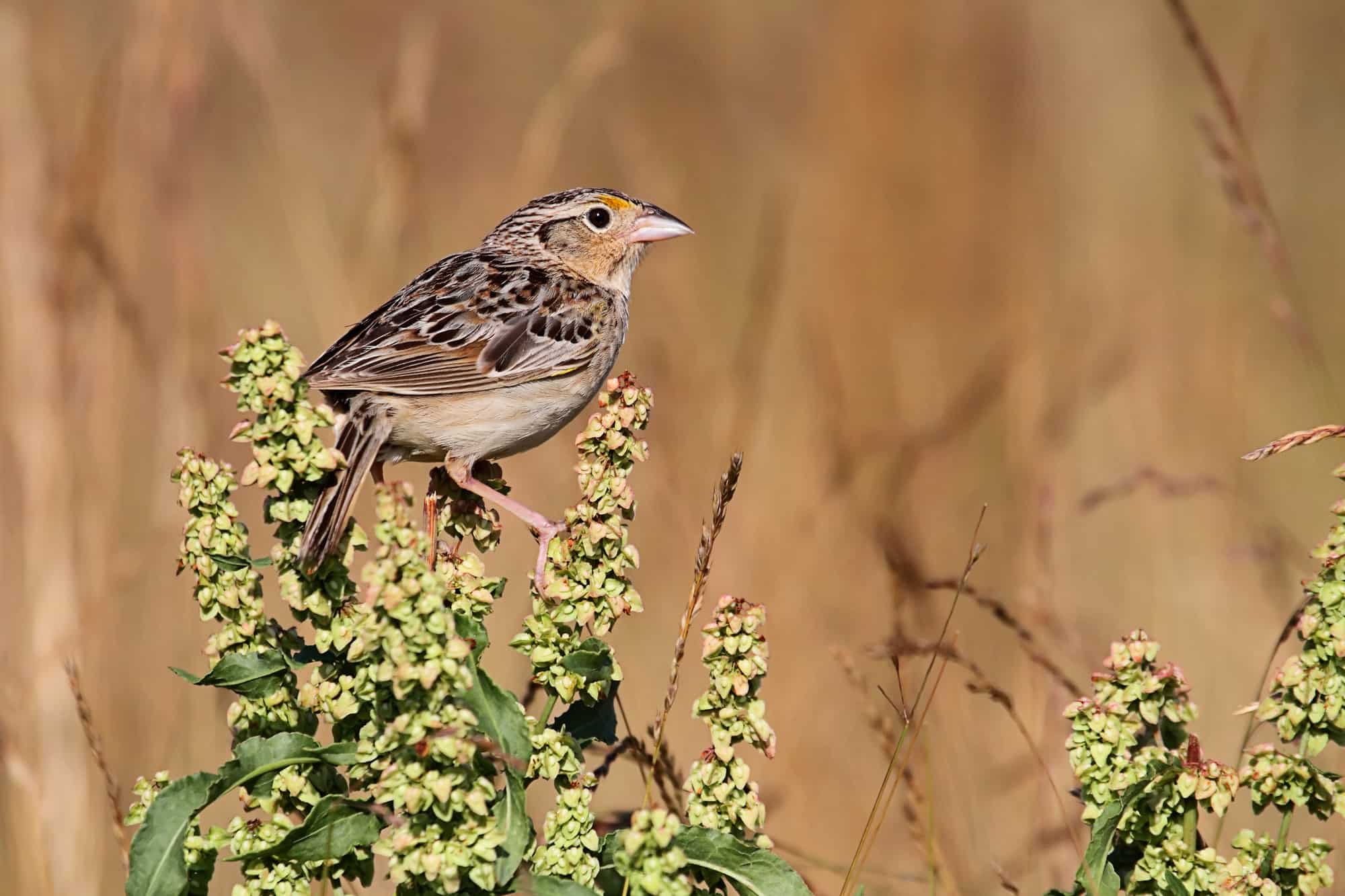
- Ammodramus savannarum
- ORDER: Passeriformes
- FAMILY: Passerellidae
- Length: 4.3-4.5 in (10.8-11.5 cm)
- Weight: 0.5-0.7 oz (14-20 g)
- Wingspan: 7.9 in (20 cm)
Grasshopper Sparrows are identifiable by sound as well as appearance. They have a signature “buzzing” sound that is similar to a grasshopper’s vibrating sounds. Additionally, males make a secondary song, which is squeaky but more musical.
To identify a Grasshopper Sparrow by sight, you’ll need to watch for a stubby tail, flat head, large bill, and thick neck. They can be light brown, gray, or even light orange.
Grasshopper Sparrows nest in New Jersey’s grassy fields, although they are less likely to stay hidden under the ground cover. They are not particularly good at flying, so you may see them on the ground or perched on a fence line.
Saltmarsh Sparrow
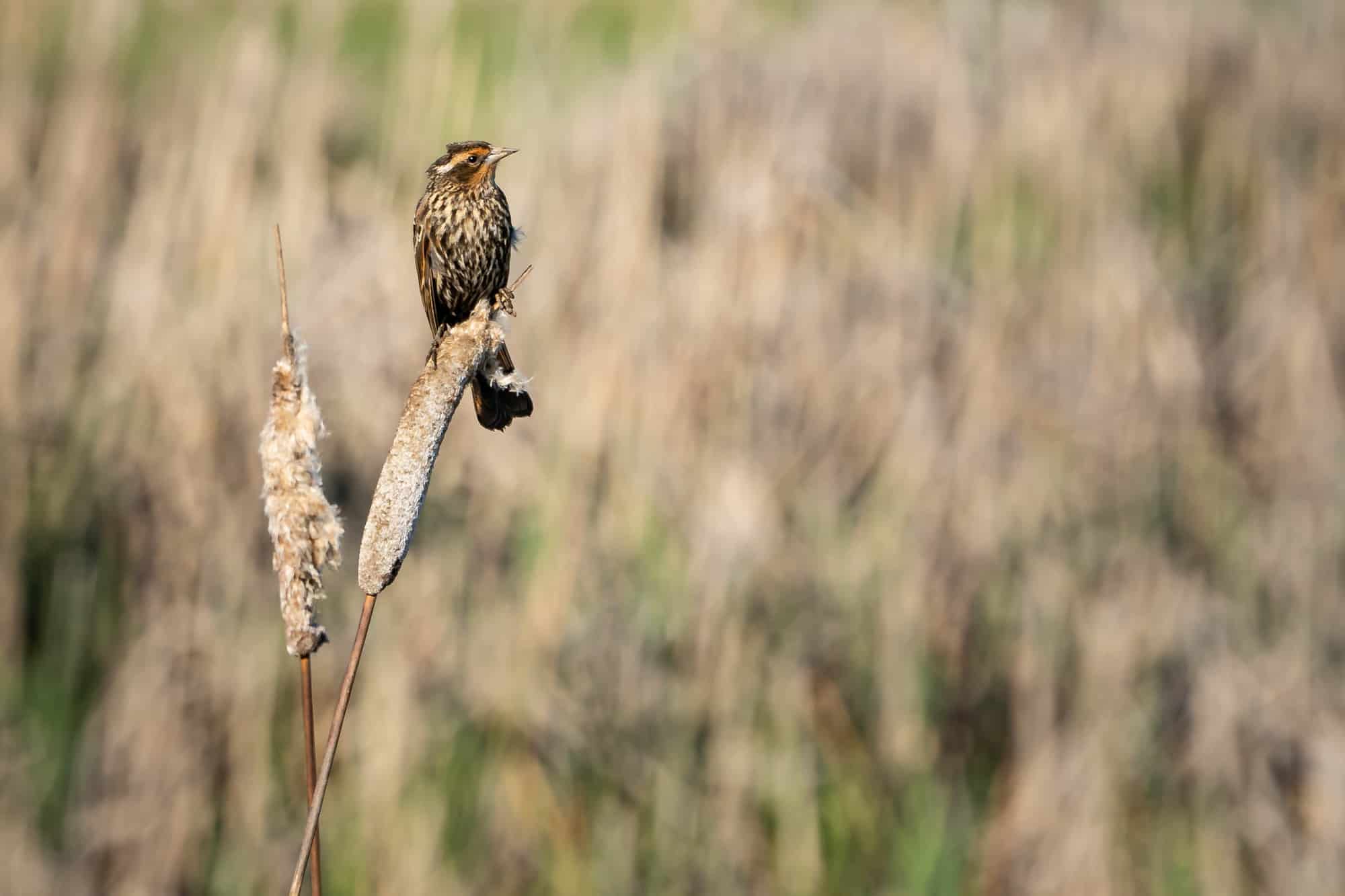
- Ammospiza caudacuta
- ORDER: Passeriformes
- FAMILY: Passerellidae
- Length: 4.7-5.1 in (12-13 cm)
- Weight: 0.6-0.8 oz (17.1-24.1 g)
- Wingspan: 6.5-7.7 in (16.5-19.5 cm)
Saltmarsh Sparrows have a very limited range. They live exclusively on the Atlantic coastline, barely moving inland. Their territory stretches from Maine to Florida. They live in New Jersey during the summer as breeding residents.
Saltmarsh Sparrows are dark gray from above and have creamy-brown bellies and chests. They have a slight yellow hue all over. The stripes on their backs are white, and their faces are orangeish-brown.
Saltmarsh Sparrows are quite difficult to spot. They hide in the marshy vegetation at the water’s edge. They are so close to the water, in fact, that the high tide will sometimes briefly spill over the nest!
Savannah Sparrow
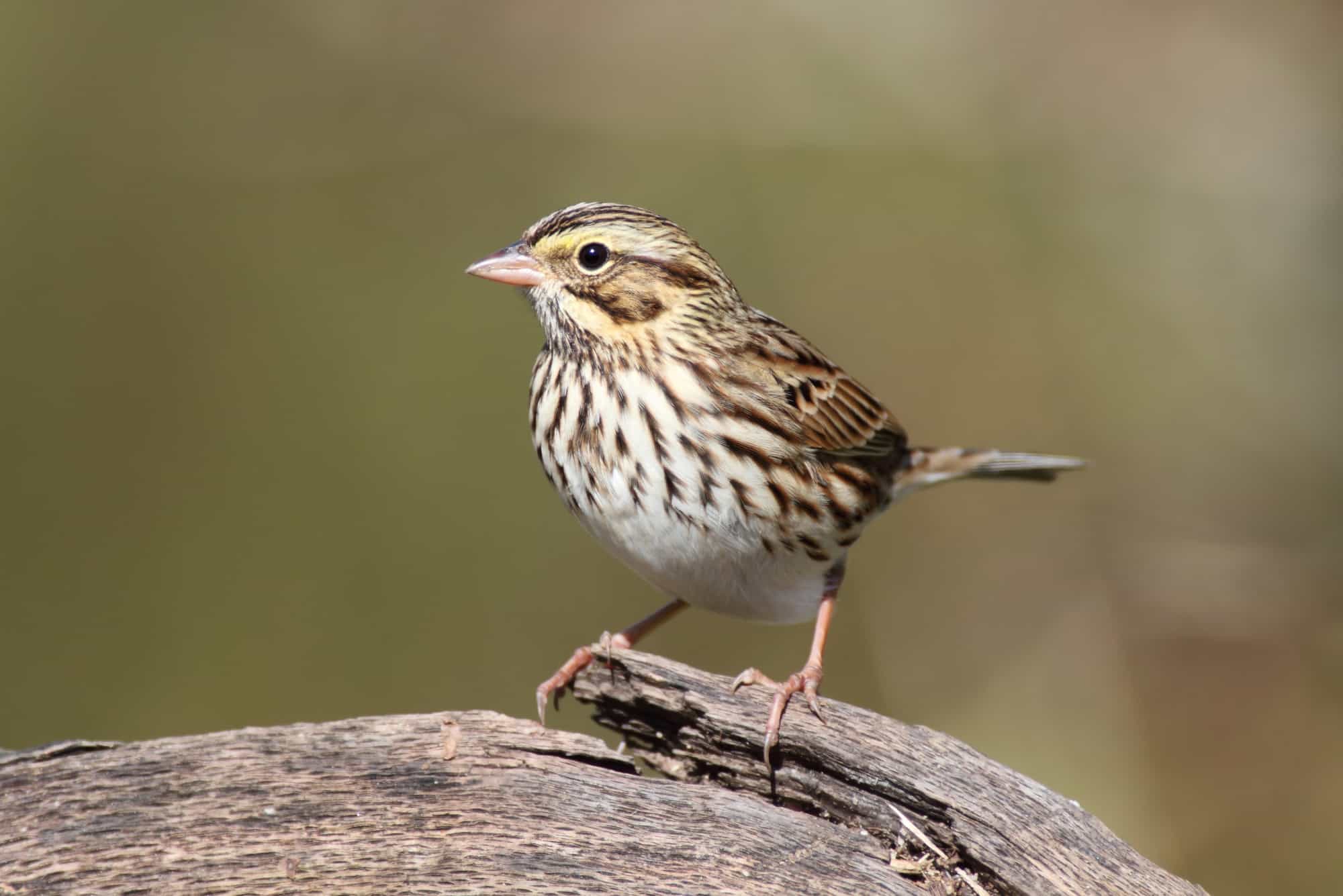
- Passerculus sandwichensis
- ORDER: Passeriformes
- FAMILY: Passerellidae
- Length: 4.3-5.9 in (11-15 cm)
- Weight: 0.5-1.0 oz (15-28 g)
- Wingspan: 7.9-8.7 in (20-22 cm)
To easily identify a Savannah Sparrow, look at the yellow line between the eyes and the bill that looks a bit like an extended eyebrow. You will also see that the Savannah Sparrow has a small head, a crown, a sharp bill, and some dark-colored streaks on its wings and back.
They breed across most of North America, including all of New Jersey.
For their nesting habitat, they find tall, dead grasses left from the previous year’s growth. Despite this excellent camouflage, Savannah Sparrows are bolder than some of their sparrow relatives. They will stand in the open and make their insect-sounding “buzzzz” sound, rather tha hiding in the underbrush.
Seaside Sparrow
- Ammospiza maritima
- ORDER: Passeriformes
- FAMILY: Passerellidae
- Length: 5.1-5.9 in (13-15 cm)
- Weight: 0.7-1.0 oz (19-29 g)
- Wingspan: 7.1-7.9 in (18-20 cm)
Seaside Sparrows are another kind of sparrow with a lot of regional variation. For example, the ones in New Jersey are dark gray from above and pale on their bellies. Farther south, they are even darker.
There is a yellow stripey spot in front of their eyes, and their throat is off-white. They have light gray streaking on their bellies and chests. Because they forage in the mud for insects, they have developed long, strong legs.
They live along the saltmarshes of the Atlantic, including New Jersey’s coastline. They stay safe from predators by hiding among the aquatic marshy grasses.
Winter-season Sparrows in New Jersey
There are 5 kinds of sparrows that come to New Jersey exclusively for the winter. They are the American Tree Sparrow, the Dark-Eyed Junco, the Fox Sparrow, the White-Crowned Sparrow, and the White-Throated Sparrow.
American Tree Sparrow
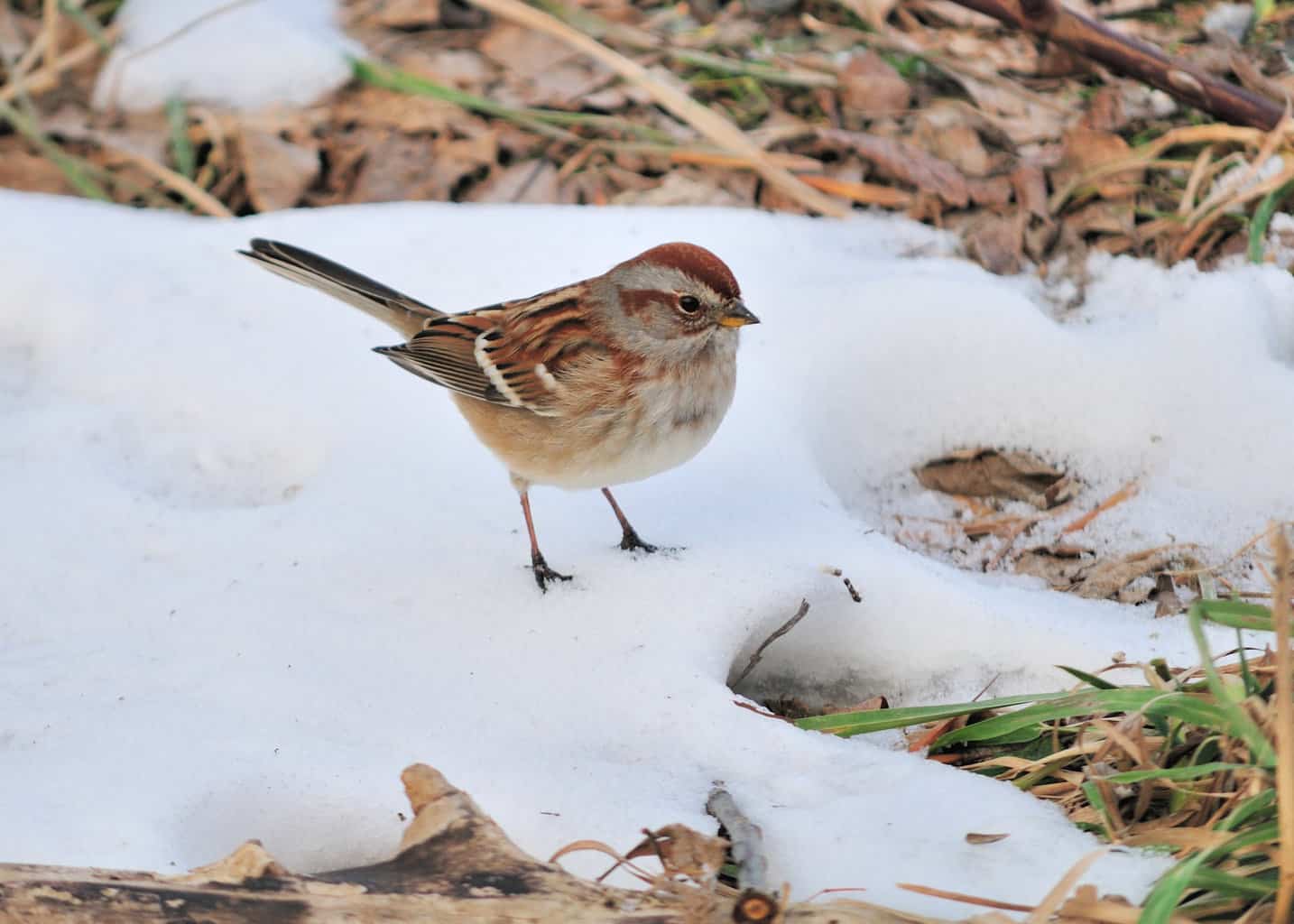
- Spizelloides arborea
- ORDER: Passeriformes
- FAMILY: Passerellidae
- Length: 5.5 in (14 cm)
- Weight: 0.5-1.0 oz (13-28 g)
- Wingspan: 9.4 in (24 cm)
The American Tree Sparrow is gray-bodied with a dark red crown. They all have striped wings, but only some of them have a red breast patch.
Their breeding territory stretches across Canada, including the frigid tundra. They migrate to most of the US for the winter, including New Jersey. New Jersey has plentiful goldenrod, which is great for birders because American Tree Sparrows often perch on the tall goldenrod bushes and sing their songs.
They are often found in thick bushes, shrubby fields, and marshes. They are often found along the edges of snowy fields.
They are almost always eating, as they need to consume 30% of their body weight in food every single day.
Dark-Eyed Junco
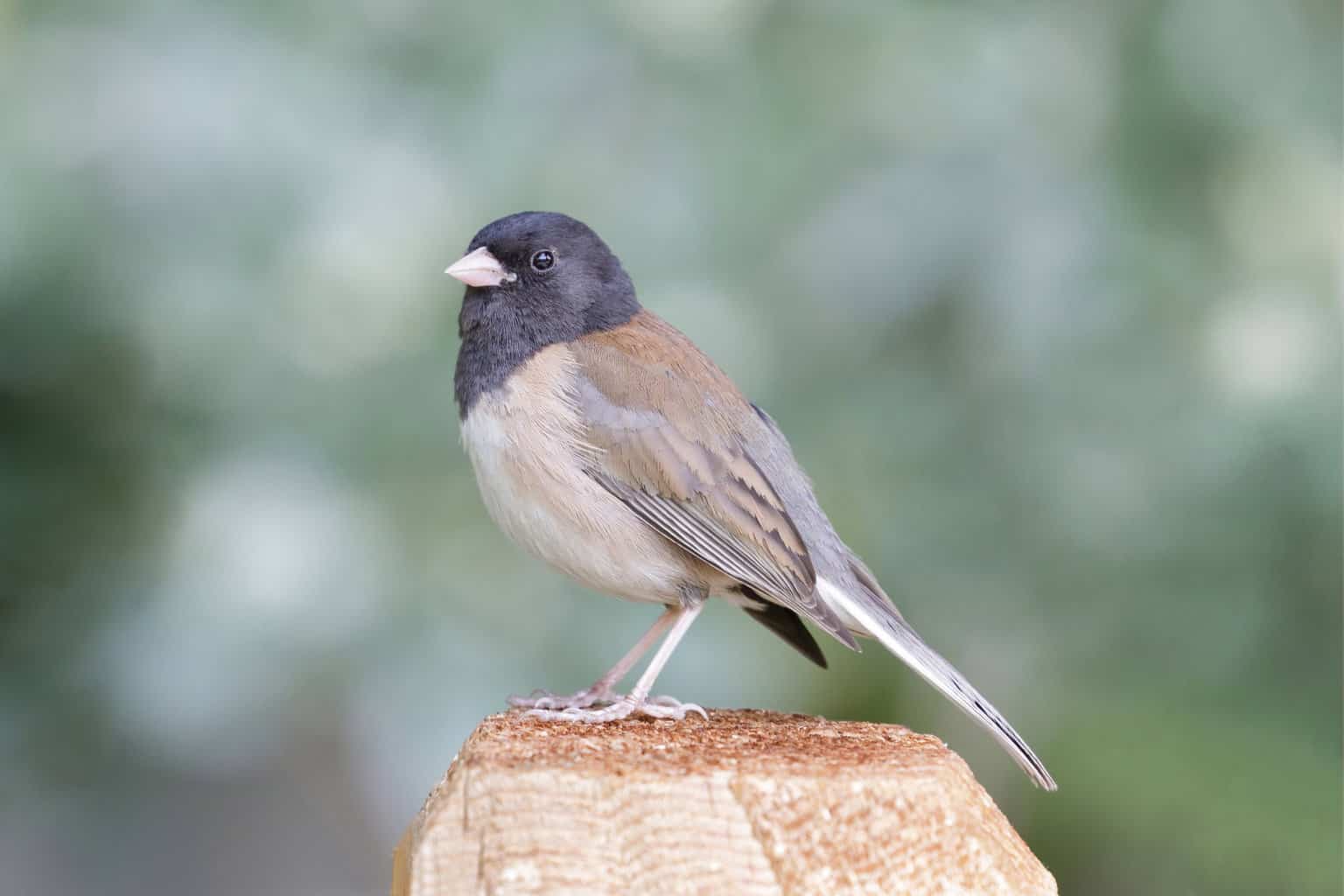
- Junco hyemalis
- ORDER: Passeriformes
- FAMILY: Passerellidae
- Length: 5.5-6.3 in (14-16 cm)
- Weight: 0.6-1.1 oz (18-30 g)
- Wingspan: 7.1-9.8 in (18-25 cm)
Dark-Eyed Juncos, with their round bodies, white bellies, and dark backs and heads, are quite cute. They have a small pink bill, too, and their outer tail feathers are white.
They are very common visitors to New Jersey’s backyard birdfeeders. Their winter arrival has earned them the nickname of “snowbirds.”
They are most common in mountainous areas, but they also prefer New Jersey’s coniferous and mixed-coniferous forests.
Dark-Eyed Juncos are always on the move, flitting about and searching for food. They are very common visitors to backyard feeders. In fact, if you put birdseed out for birds in the winter in New Jersey, you are very likely going to see some Dark-Eyed Juncos come to visit!
Fox Sparrow

- Passerella iliaca
- ORDER: Passeriformes
- FAMILY: Passerellidae
- Length: 5.9-7.5 in (15-19 cm)
- Weight: 0.9-1.6 oz (26-44 g)
- Wingspan: 10.5-11.4 in (26.7-29 cm)
The Fox Sparrow’s overall coloring is reddish-brown. They have thick brown spots on their gray chests. The amount of red on their bodies can vary greatly from bird to bird. Some will have a lot of striping, and others will have just a few stripes. Some will be almost entirely red!
They are known for kicking leaf litter into the air as they forage through leaves, dirt, roots, and mulch. In the winter, their diet is mostly made up of seeds, and they will happily visit New Jersey’s backyard bird feeders.
Fox Sparrows are winter residents throughout New Jersey. They like to hide in shrubs and bushes.
Interestingly, there have been Fox Sparrows spotted in many other places around the world, including Germany, Ireland, Iceland, Greenland, and Italy. However, these are not migratory vagrants. Instead, they likely ended up in those places by traveling on ships.
White-Crowned Sparrow
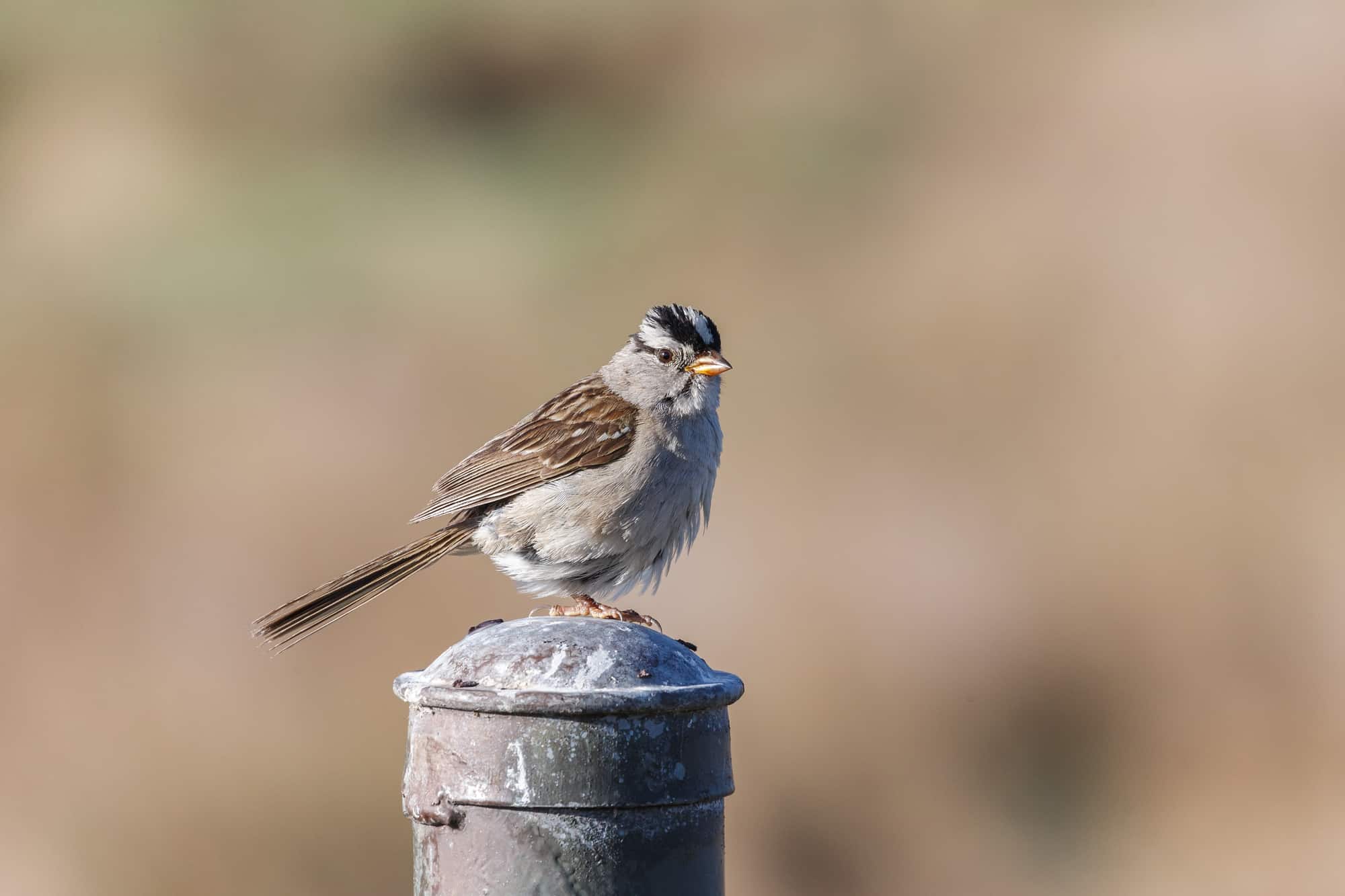
- Zonotrichia leucophrys
- ORDER: Passeriformes
- FAMILY: Passerellidae
- Length: 5.9-6.3 in (15-16 cm)
- Weight: 0.9-1.0 oz (25-28 g)
- Wingspan: 8.3-9.4 in (21-24 cm)
Although the White-Crowned Sparrow is large for a sparrow, it’s still a small bird. Their white-colored crown can raise and lower, just a bit, as an additional method of communication with other birds.
Their coloring is relatively plain, but they do have some dramatic black and white head stripes. Their bodies are round, and their bills are either pink or yellow.
They are winter residents of New Jersey, as well as much of the rest of North America. Look for them in grasslands and fields. They are also frequent visitors to backyard feeders.
White-Throated Sparrow
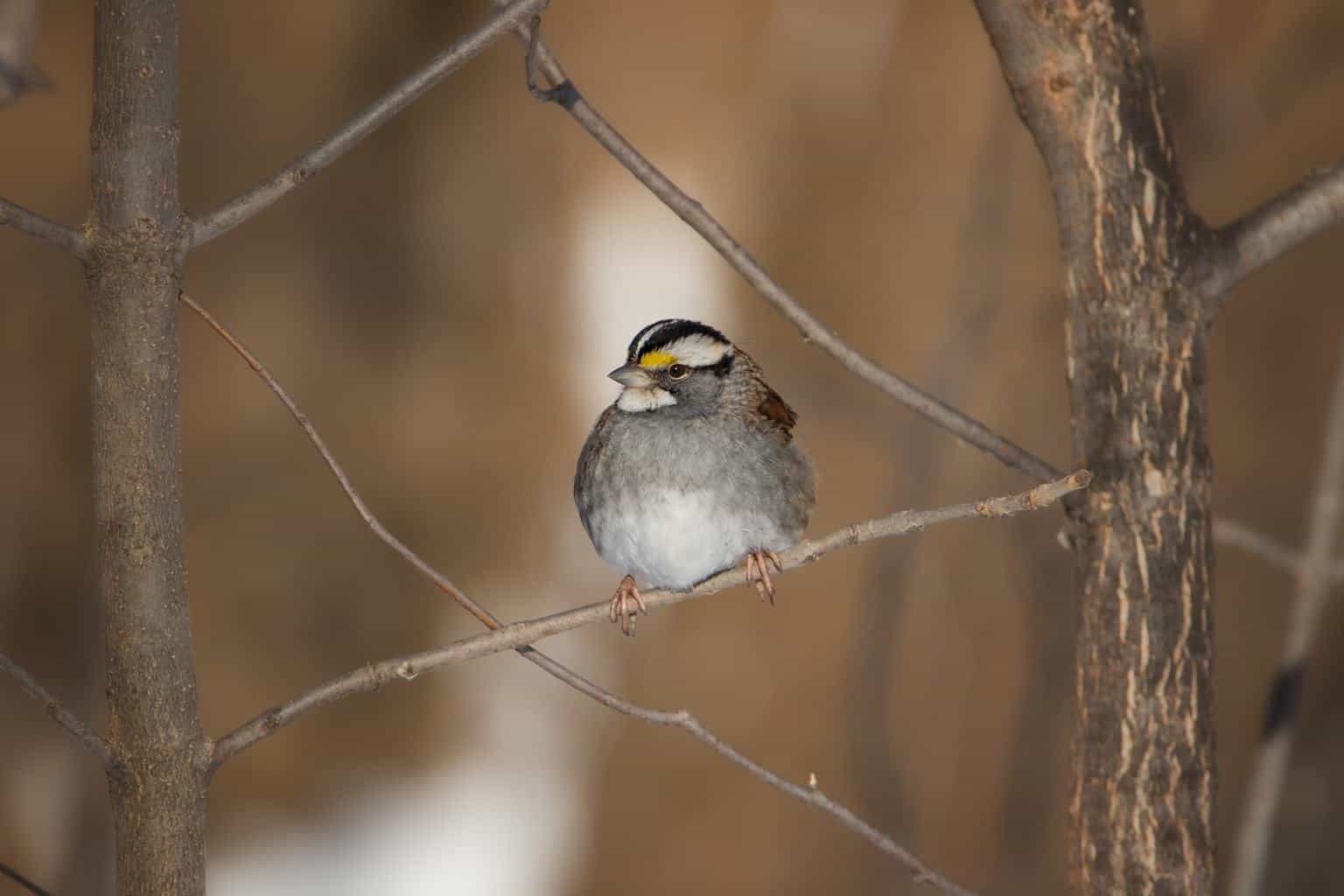
- Zonotrichia albicollis
- ORDER: Passeriformes
- FAMILY: Passerellidae
- Length: 6.3-7.1 in (16-18 cm)
- Weight: 0.8-1.1 oz (22-32 g)
- Wingspan: 7.9-9.1 in (20-23 cm)
It’s easy to remember what the White-Throated Sparrow looks like, thanks to its tell-tale name. It has a white throat and a dark brown body. There are thick black stripes on their head and across their eyes. They have yellow lores — that’s the space between the eye and the bill.
White-Throated Sparrows sometimes mate with Dark-Eyed Juncos, but we don’t see this activity in New Jersey, as they are winter-only residents here.
They like open wooded areas with plenty of undergrowth for shelter and camouflage.
Migratory Sparrows in New Jersey
There are only 3 kinds of sparrows that migrate through New Jersey as they travel between spring and summer: Lincoln’s Sparrow, Nelson’s Sparrow, and the Vesper Sparrow.
Lincoln’s Sparrow
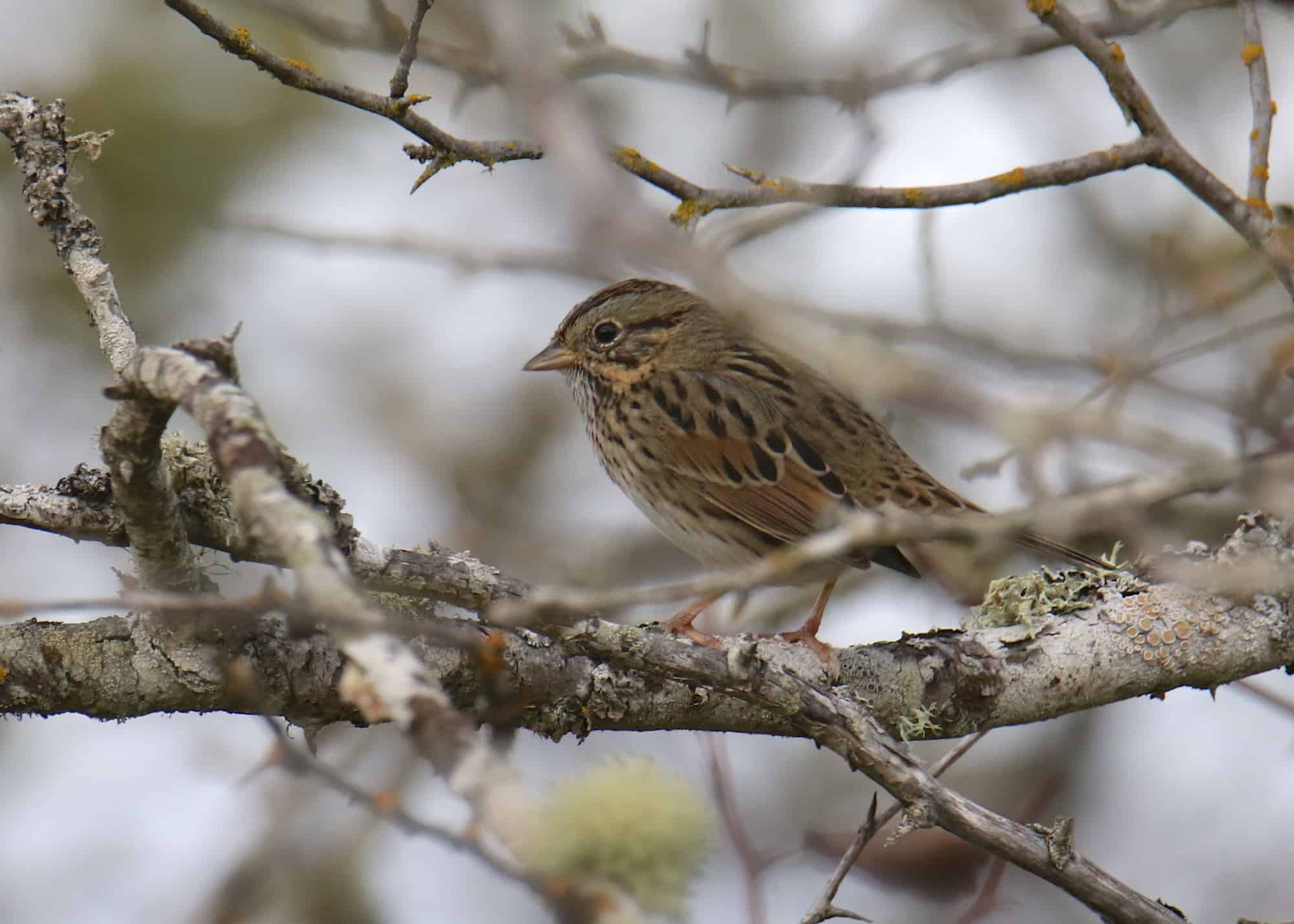
- Melospiza lincolnii
- ORDER: Passeriformes
- FAMILY: Passerellidae
- Length: 5.1-5.9 in (13-15 cm)
- Weight: 0.6-0.7 oz (17-19 g)
- Wingspan: 7.5-8.7 in (19-22 cm)
Lincoln’s Sparrows are mostly gray with dark brown stripes. The tips of their tails and wings are rusty-brown, and they have white bellies. On their face, they have a pale mustache. Their head has a gray stripe right down the middle of the crown.
That crown, by the way, can just barely raise up, which means sometimes Lincoln’s Sparrows look like they have a minuscule crest.
They migrate through New Jersey between late March and May, and then again starting in September.
In Canada, their nesting habitat includes wet meadows. In the winter, they prefer bushes and thickets. While they migrate, you can often hear them singing from within thickets along roadsides and forest edges.
Nelson’s Sparrow
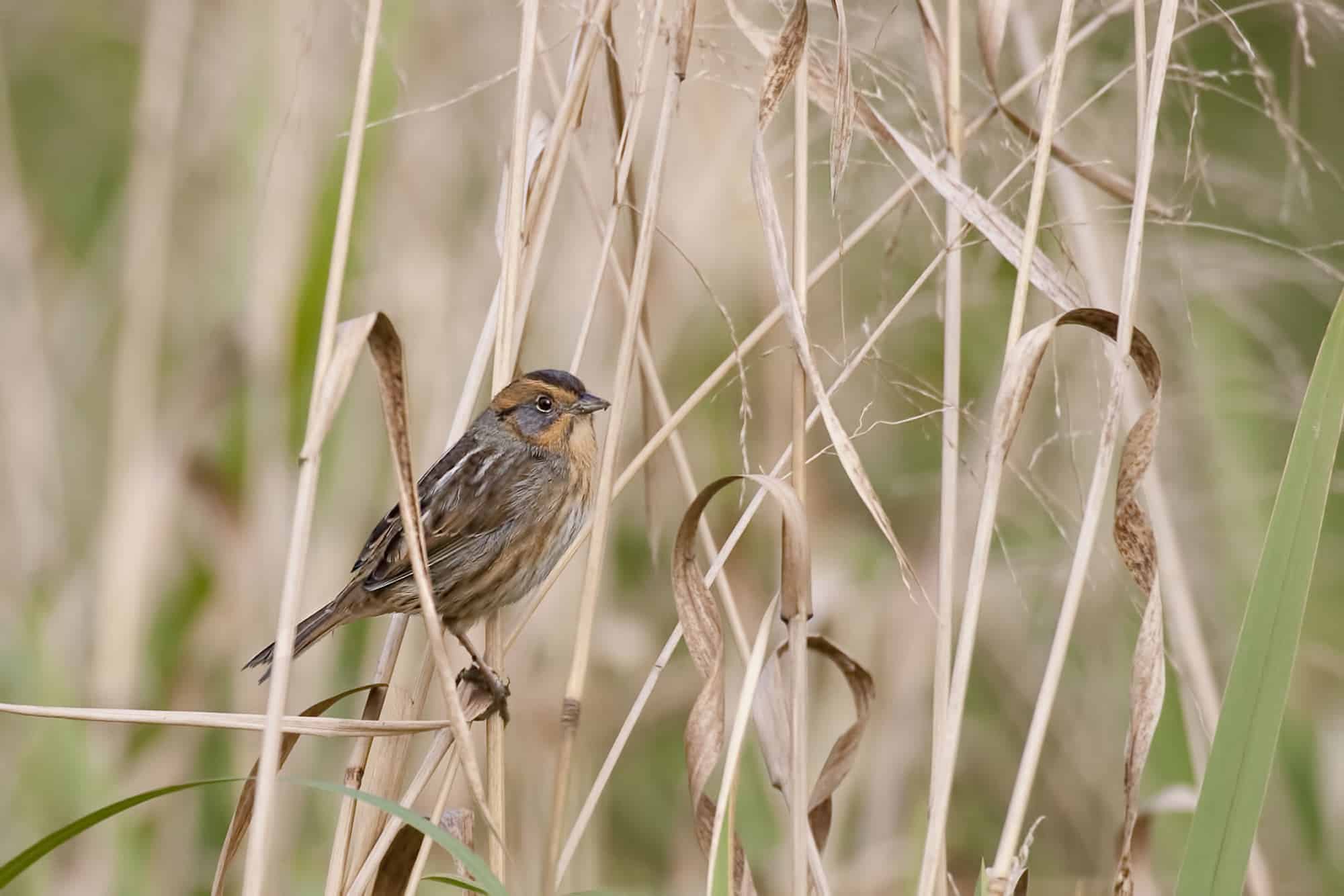
- Ammospiza nelsoni
- ORDER: Passeriformes
- FAMILY: Passerellidae
- Length: 4.3-5.1 in (11-13 cm)
- Weight: 0.6-0.7 oz (17-21 g)
- Wingspan: 6.5-7.9 in (16.5-20 cm)
On the coast, the yellow Nelson’s Sparrow has brown markings on its chest, head, neck, and back. The belly is buff. Inland Nelson’s Sparrows have darker coloration.
Their main breeding grounds are in Alberta and Saskatchewan, Canada, but they are migratory visitors to New Jersey as they make their way to their winter territory further south. Many of the Nelson’s Sparrows that stop in New Jersey have traveled from breeding grounds along the Hudson Bay and Gulf of St. Lawrence.
While here, they stay close to the coastline in New Jersey, rarely traveling inland.
Nelson’s Sparrows were only given their name in 2009 when they were differentiated from the Saltmarsh Sparrow. Before that, both species were thought to be one kind of sparrow: The Sharp-Tailed Sparrow. Nelson’s Sparrows are named for famed American naturalist Edward William Nelson.
Vesper Sparrow
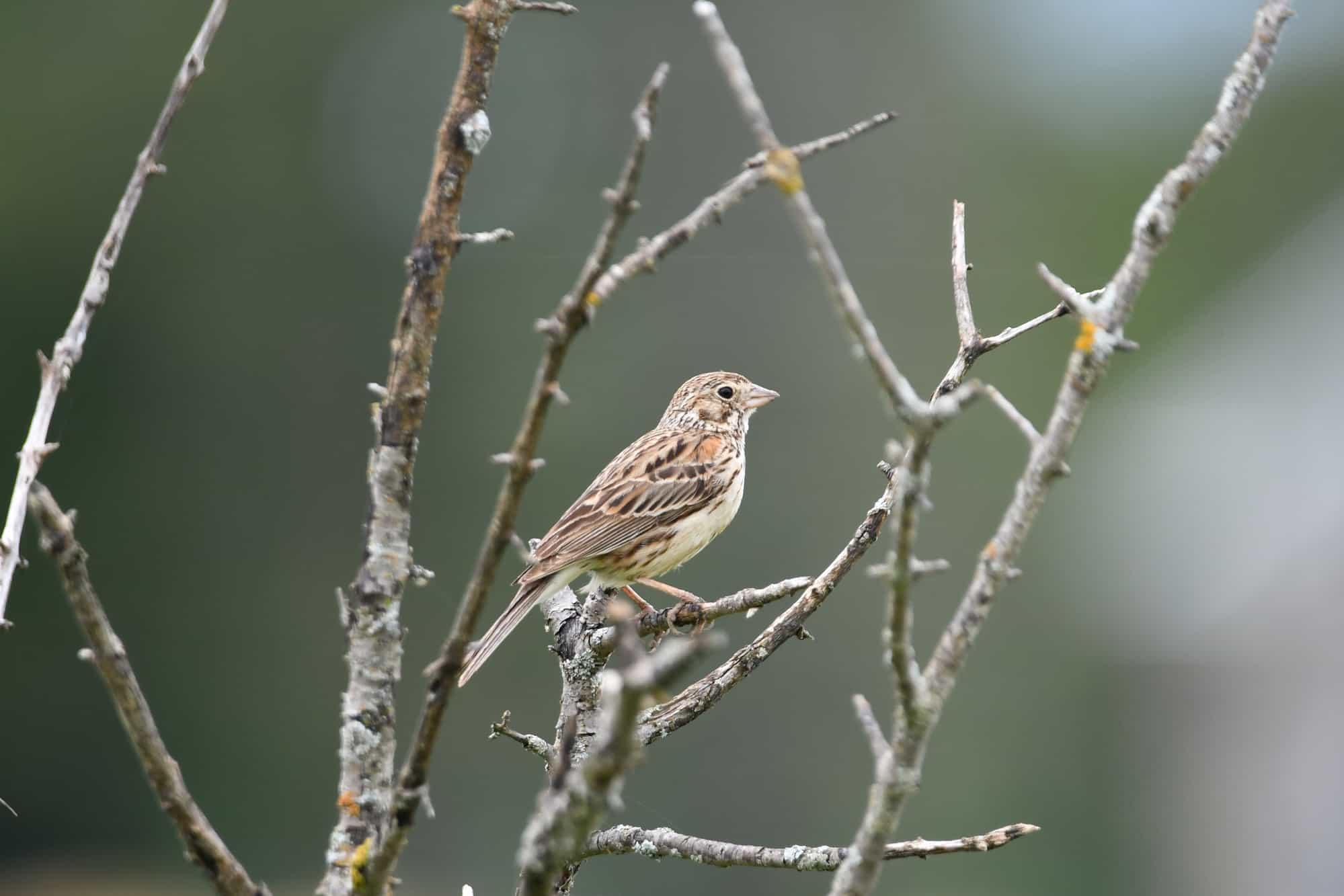
- Pooecetes gramineus
- ORDER: Passeriformes
- FAMILY: Passerellidae
- Length: 5.1-6.3 in (13-16 cm)
- Weight: 0.7-1.0 oz (20-28 g)
- Wingspan: 9.4 in (24 cm)
As one of the largest kinds of sparrows in North America, the Vesper Sparrow has chestnut-brown shoulder patches, a streaky brown body, and white eyerings.
They get their name from the beautiful, melodic song that they sing at dusk. Vespers are the traditional services held at sundown in some Christian traditions.
They are not residents of New Jersey. Rather, they travel through on their migration routes. However, because New Jersey is so close to their breeding range, it’s always possible that a few birds will nest here.
They nest right on the ground, but in addition to nesting near the cover of tall grass, they will also build their nests next to a protective log or fallen branch.
Finding Sparrows in New Jersey
In addition to plentiful sparrows, check out our guide to Birds in New Jersey! There are so many fascinating birds to see in this state.
Whether you live here or are visiting, you can enjoy the wildlife and birdlife that New Jersey has to offer. It may be true that identifying sparrows can be a challenge, but that doesn’t mean it is impossible! it just takes a bit of practice and attention to detail!
Good luck spotting each of these 18 interesting sparrows in New Jersey!

